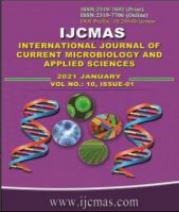


 National Academy of Agricultural Sciences (NAAS)
National Academy of Agricultural Sciences (NAAS)

|
PRINT ISSN : 2319-7692
Online ISSN : 2319-7706 Issues : 12 per year Publisher : Excellent Publishers Email : editorijcmas@gmail.com / submit@ijcmas.com Editor-in-chief: Dr.M.Prakash Index Copernicus ICV 2018: 95.39 NAAS RATING 2020: 5.38 |
The efficacy of three commercial microbial formulations viz., Bacillus thuringiensis, Beauveria bassiana and Metarhizium anisopliae were evaluated at different doses on the percent pupation success of diamondback moth. These formulations were tested on 6 days old larvae of the pest in the laboratory of Department of Entomology, College of Agriculture, Central Agricultural University, Imphal during 2019-2020. In the present investigation it was observed that all the microbial formulations were effective to suppress pupation as compared to control treatment. At 72 days after treatment, larvae initiated pupation. After 144 hours of treatment, least pupation was observed with Beauveria bassiana @4g/l (25.00%) whereas all doses of M.anisopliae and B. thuringiensis reported percent pupation success ranging from 45-52.50% and 42.50-60% respectively. Considering the parameter mentioned, it was concluded that Beauveria bassiana was the most effective microbial insecticide to retard pupation of diamondback moth, followed by M. anisopliae and B.thuringiensis.
 |
 |
 |
 |
 |